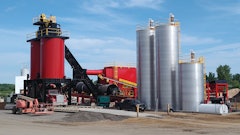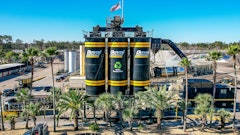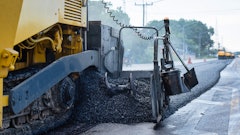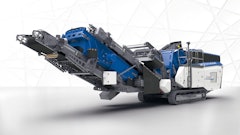
Wonder what the difference is between a mat using warm mix compared with hot mix? You could make a visit to Pennsylvania for a side-by-side comparison. But it would be a long way to go - to not see very much.
"There's no difference," says Tom Abbey, director of quality control for Glenn O. Hawbaker Inc., PA. "We did our first job, a lot and driveway on a farm, with warm mix over a year ago.
"Half of the lot was hot mix, the other warm mix," he continues. "We placed them side-by-side, and you can't tell the difference."
But there is a difference when you look at the costs.
"The advantage that we've seen so far has been the reduction in temperature, which translates directly into energy savings at the plant," Abbey says. "You're lowering fuel consumption as you lower the temperature."
A positive change
Hawbaker has studied a variety of warm mix technologies and is encouraged by all the potential benefits from warm mix.
"Lowering energy consumption, emissions, employee exposure to excessive heat and fumes - all are good things," Abbey says.
Abbey believes in changing to warm mix, but had to be convinced before signing on. "I'm one of those old-fashioned guys: change is good if there's a reason for it," he says.
In this case there are several - including cost.
"It's early, and because of the relatively small tonnages we've laid down so far, it's hard to get a grasp around what, exactly, the fuel savings are," Abbey says. He estimated the savings at between 10% and 25% - about the same as is being reported nationally.
However, there are other warm mix benefits. They include:
- Lower emissions. If less fuel is consumed, emissions drop. "Lowering emissions is crucial in this day and age," Abbey says.
- When done right, only a few drops of water are required. Hawbaker uses the Gencor Ultrafoam GX, which creates the warm mix by combining the AC with water, actually foaming the asphalt. "That's the way to go," Abbey says.
He explored other options - including those that required chemicals and wax pellets - while working on a pilot project for the Pennsylvania DOT.
This project required using four different warm mix technologies. "You're always better off not using additives if you don't have to," Abbey says. "The other approaches - with the exception of Gencor - require costs each time you produce a warm mix. With the Ultrafoam, there is a one-time purchase fee, a one-time installation fee, which isn't very much - and that's it. We're not buying a weekly or monthly chemical supply, and we don't have to worry about the cost of those chemicals skyrocketing in a year or two. We don't have to store those materials either." Hawbaker has seen little or no impact on its water bill. "The Gencor process does not use a significant amount of water."
- Laydown crews appreciate the cooler temperatures. "We sell mix to customers who serve the home-owner market, and put in parking lots and driveways," Abbey says. Those customers appreciate warm mix, he says. "They really like it because in July and August, when the ambient temperature is more than 90 degrees, they get a mix that's 50 degrees cooler than traditional hot mixes." Hawbaker's own crews also appreciate the lower temperatures - among other benefits. "Besides the lower temperatures, there are fewer fumes and reduced odors."
- Laydown crews don't have to be retrained to use warm mix. "In the field, we don't treat warm mix any different than hot mix," Abbey says. "No changes to good workmanship in the field or to good processes at the plant are required. There's no difference in my mind regarding the mix; you're just lowering the temperature of the mix." Warm mix leaves the plant at 240º to 260º F and typically arrives at the jobsite at a temperature of about 230º F. "It doesn't cool down as fast as hot mix," Abbey says. "It allows for an extended haul distance and compaction period."
- Warm mix requires minimal adjustment by the staff at the plant. Installation is a simple process. "Then you start your plant. When you want to make warm mix, you flip the switch so the Ultrafoam pump starts injecting water," Abbey says. "Then you back the burner control down to lower the temperature. It's that easy."
- Warm mix is just as durable as hot mix. Warm mix hasn't been around long enough for Abbey to draw specific conclusions regarding its longevity, but he is encouraged by the results. "You're not over-aging, pre-aging or oxidizing the mixture when achieving the lower temperatures," he says. "I think longevity of the mix will increase. I can't predict for sure, but I think it will last just as long as or longer than hot mix."
It's been about a year and a half since Hawbaker's crew ran that first test on the farmer's lot. Those curious about warm mix have visited the site. After being assured there is no difference, they then place an order.
"We've now done more than a few dozen jobs with warm mix since that first job," Abbey says. "The biggest and most recent was from our DuBois plant. Over 20,000 tons of 19mm Superpave binder-leveling course was placed for the Pennsylvania DOT in Elk County. All QA/QC criteria was met for mixture and density specifications."
Hawbaker's second Ultrafoam GX system was installed in the spring of 2009 after being removed from another plant in Milroy.
"Warm mix works well, and has so many benefits," Abbey says. "I agree with others who predict that within five years, at least half of all asphalt production could be, and should be, warm mix."
Making the switch
Converting to warm mix was "about as simple as it gets," according to Abbey.
"Scott Letterman, asphalt plant manager at Hawbaker's Pleasant Gap, and his people had to cut into the asphalt supply line for the installation of the Ultrafoam GX system, but that didn't take much," Abbey says. "Other than that, it was just a mechanical adaptation to the plant; piping of the water pump and supply line; and a few programming changes to the control system."
Plant personnel worked on the switch in their spare time.
"It took no more than 10 hours total," Abbey says "We easily could have done it in a day if we just worked on it," he explains. "But we did it at the end of the day, or first thing in the morning, so we never had to shut down. It required very minimal plant alterations."
Hawbaker crews have installed two Ultrafoam systems. The process is so easy that a third plant has the right parts and pieces in place - just in case.
"If we get a contract, or demand increases to where we need more warm mix, we'll just switch it out and be ready to go," says Abbey.





























